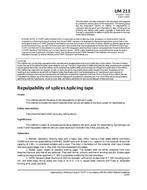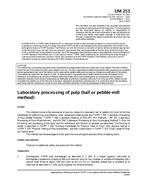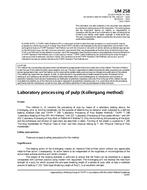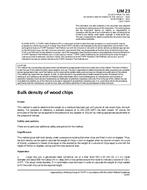Description
1.1 This method provides a quick, reliable means to measure the zero-span tensile strength of a randomly oriented specimen of fibers when dry.
1.1.1 Similar procedures for determining the zero-span tensile strength of a randomly oriented specimen of fibers when wet are found in TAPPI T 273 “Wet Zero-Span Tensile Strength of Pulp” (currently withdrawn).
1.2 In this test method, the fibers are tested as a handsheet produced using a standardized procedure such as TAPPI T 205 “Forming Handsheets for Physical Tests of Pulp.”
1.3 While testing is possible on finished paper materials, information on fiber quality from intermediate steps in the pulping or papermaking process, or both, is frequently more useful for improving finished paper quality or improving fiber utilization of, for example, recycled fibers, or fibers subjected to new pulping, bleaching, or finishing processes.
1.4 The modifications of the standard procedure described in this test method required for testing finished paper is straightforward, however testing must be done in the two principle directions of the sheet, as required in TAPPI T 494 “Tensile Breaking Properties of Paper and Paperboard (using Constant Rate of Elongation Apparatus),” since the finished paper or paperboard will generally have non-random fiber orientation, resulting in different strength properties in the two principle directions of the finished sheet. Testing of sheets having a grammage greater than 100 g/m2, which includes some paper materials described as paper and many paperboards, is difficult because of problems associated with clamping of individual fibers as the number of fibers per unit area increases.
1.5 Such modifications are not described in this test method, and if they are made, they must be acknowledged and clearly described in the Report as deviations from the standard procedure.
1.6 In addition to a measure of the dry zero-span tensile strength of the specimen of fibers, an index of the cohesiveness of fibers in the sheet is also provided by the ratio of the tensile strength determined using TAPPI T 494 and the tensile strength determined using this test method when all testing is done on handsheets having random fiber orientation (1).
1.7 Two instrumental approaches for accomplishing the measurement of dry tensile strength at zero-span are described.
1.7.1 One approach is use a specially constructed pair of “zero-span” jaws which are used in conjunction with a conventional tensile testing machine1.
1.7.1.1 One such design for “zero-span” jaws was proposed by Clark (1). A second design was proposed by Wink and Van Eperen (2).
1.7.2 A second approach incorporates both “zero-span” jaws and measurement and readout devices in a single instrument1.
1.7.3 When properly adjusted and calibrated, either approach may be used to perform this test.
Product Details
- Published:
- 01/01/2007
- Number of Pages:
- 11
- File Size:
- 1 file , 850 KB
- Note:
- This product is unavailable in Ukraine, Russia, Belarus




